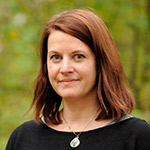Mari Jönsson

Presentation
Associate Professor (Docent) Mari Jönsson has a special interest in the ecology and conservation of epiphytic lichens and wood-inhabiting fungi. She completed her PhD at Mid Sweden University, where she studied how natural and anthropogenic disturbances influence forest structure and ecological processes, with a particular focus on woodland key habitats and the dynamics of deadwood and wood-inhabiting fungi.
During her postdoc at the Swedish University of Agricultural Sciences (SLU), she investigated the biodiversity of epiphytic lichens in relation to tree dieback, environmental and historical factors in traditionally managed, grazed, and overgrown wooded meadows on the island of Gotland.
At SLU’s Swedish Species Information Centre (SLU Artdatabanken), she continued to work on the conservation of forest biodiversity and the effects of various conservation strategies in forestry. Mari is also engaged in research using citizen science data, including observations submitted to the Swedish Species Observation System (Artportalen).
In her current position as a researcher at the Department of Ecology at SLU, she leads several projects, including:
- Ecological compensation through translocation and restoration of dead wood and associated species communities,
- Diversity and dynamics of wood-inhabiting fungi, and their role in decomposition and CO₂ fluxes from dead wood,
- The Minedust project, studying the effects of mine dust deposition in northern Sweden on biodiversity and ecosystem services in adjacent forest landscapes,
- Conservation values of retention forestry, with a focus on their importance for biodiversity, microclimate buffering, and the impacts of summer drought in small, edge-influenced fragmented forests.
Her research is supported by funding from Formas, the Swedish Research Council, Skogssällskapet, and Vinnova, among others.
Teaching
Course leader for Cryptogams and nature conservation
Cooperation
Study Director of the Basic Education
Publications list:
